The Impact of Employee Engagement on Organizational Performance
VerifiedAdded on 2023/06/04
|10
|2959
|400
Essay
AI Summary
This essay delves into the critical concept of employee engagement, defining it as the investment of an individual's complete self in their job, and highlighting its significance in today's competitive global landscape. The paper identifies key drivers of employee engagement, including effective recruitment and selection processes, well-designed jobs, employee empowerment, training and development programs, fair incentives and compensation, and open communication channels. It then examines the various outcomes of employee engagement, categorizing them into employee and organizational results. Employee outcomes include improved health and well-being, and clarified expectations, while organizational outcomes encompass enhanced employee retention, increased bottom-line profits, heightened customer loyalty, improved employee productivity, successful organizational change implementation, a positive organizational culture, and enhanced manager self-efficacy. The essay underscores the importance of recognizing employees as a crucial variable for organizational success, and it concludes by emphasizing the competitive advantage that organizations with high levels of employee engagement possess.
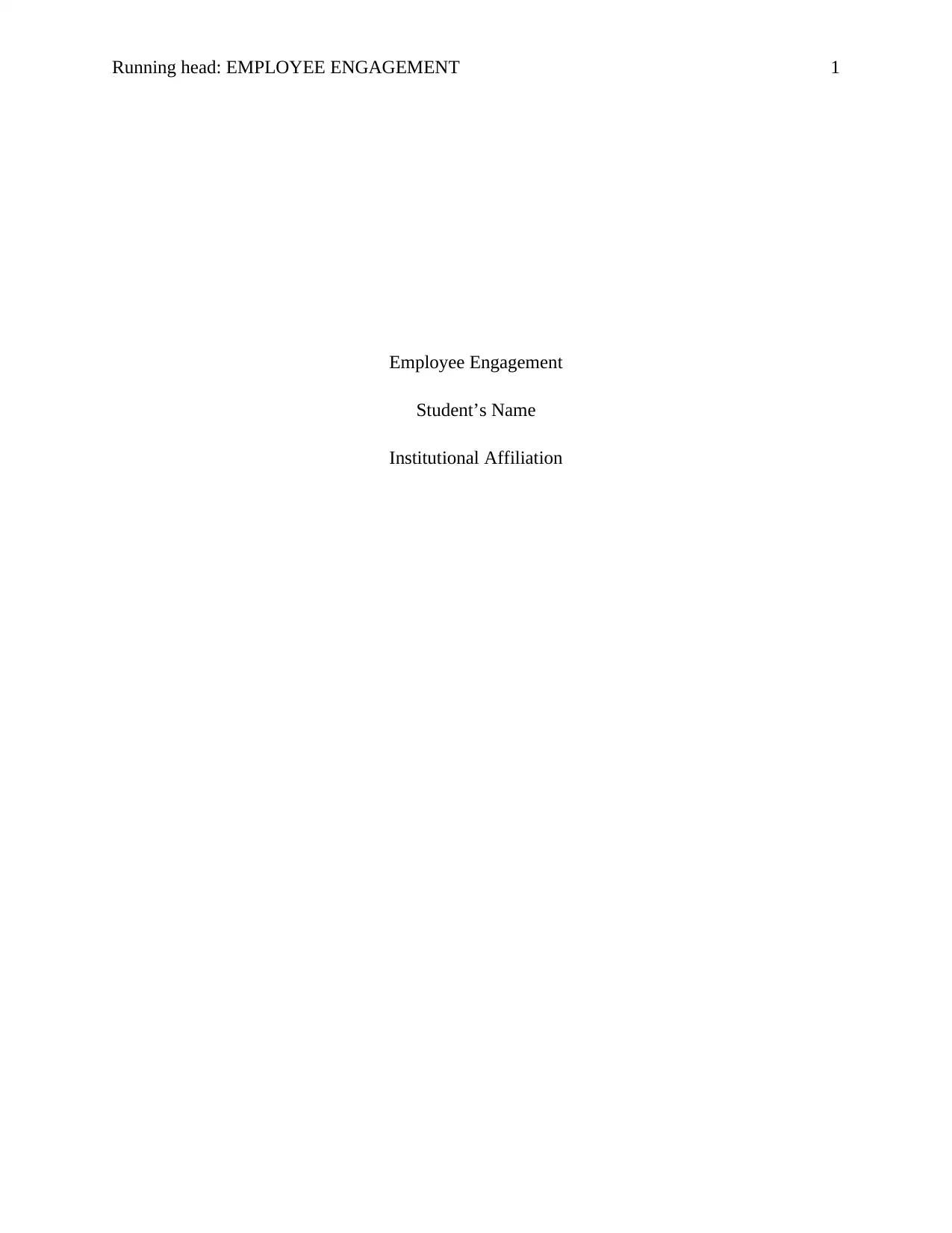
Running head: EMPLOYEE ENGAGEMENT 1
Employee Engagement
Student’s Name
Institutional Affiliation
Employee Engagement
Student’s Name
Institutional Affiliation
Paraphrase This Document
Need a fresh take? Get an instant paraphrase of this document with our AI Paraphraser
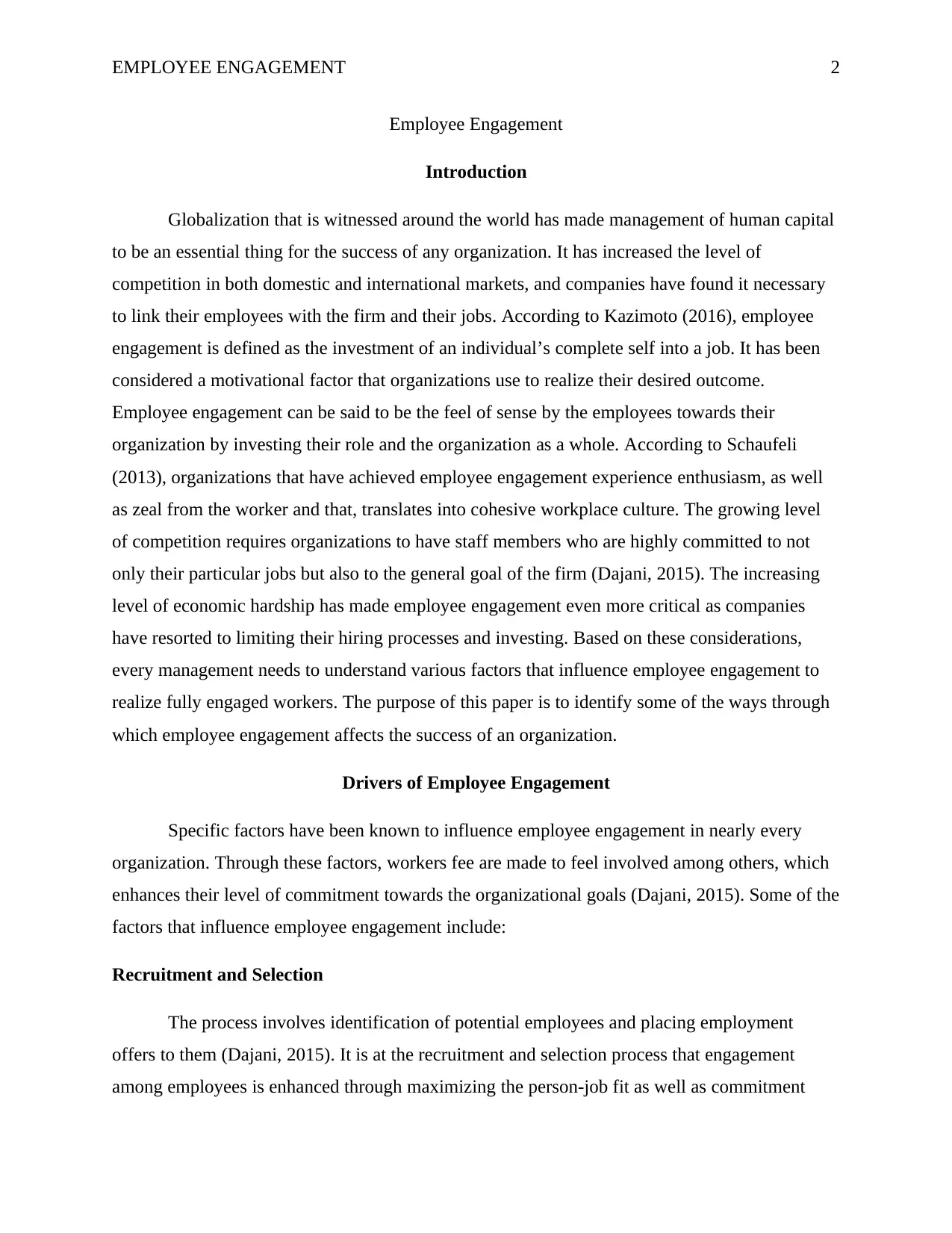
EMPLOYEE ENGAGEMENT 2
Employee Engagement
Introduction
Globalization that is witnessed around the world has made management of human capital
to be an essential thing for the success of any organization. It has increased the level of
competition in both domestic and international markets, and companies have found it necessary
to link their employees with the firm and their jobs. According to Kazimoto (2016), employee
engagement is defined as the investment of an individual’s complete self into a job. It has been
considered a motivational factor that organizations use to realize their desired outcome.
Employee engagement can be said to be the feel of sense by the employees towards their
organization by investing their role and the organization as a whole. According to Schaufeli
(2013), organizations that have achieved employee engagement experience enthusiasm, as well
as zeal from the worker and that, translates into cohesive workplace culture. The growing level
of competition requires organizations to have staff members who are highly committed to not
only their particular jobs but also to the general goal of the firm (Dajani, 2015). The increasing
level of economic hardship has made employee engagement even more critical as companies
have resorted to limiting their hiring processes and investing. Based on these considerations,
every management needs to understand various factors that influence employee engagement to
realize fully engaged workers. The purpose of this paper is to identify some of the ways through
which employee engagement affects the success of an organization.
Drivers of Employee Engagement
Specific factors have been known to influence employee engagement in nearly every
organization. Through these factors, workers fee are made to feel involved among others, which
enhances their level of commitment towards the organizational goals (Dajani, 2015). Some of the
factors that influence employee engagement include:
Recruitment and Selection
The process involves identification of potential employees and placing employment
offers to them (Dajani, 2015). It is at the recruitment and selection process that engagement
among employees is enhanced through maximizing the person-job fit as well as commitment
Employee Engagement
Introduction
Globalization that is witnessed around the world has made management of human capital
to be an essential thing for the success of any organization. It has increased the level of
competition in both domestic and international markets, and companies have found it necessary
to link their employees with the firm and their jobs. According to Kazimoto (2016), employee
engagement is defined as the investment of an individual’s complete self into a job. It has been
considered a motivational factor that organizations use to realize their desired outcome.
Employee engagement can be said to be the feel of sense by the employees towards their
organization by investing their role and the organization as a whole. According to Schaufeli
(2013), organizations that have achieved employee engagement experience enthusiasm, as well
as zeal from the worker and that, translates into cohesive workplace culture. The growing level
of competition requires organizations to have staff members who are highly committed to not
only their particular jobs but also to the general goal of the firm (Dajani, 2015). The increasing
level of economic hardship has made employee engagement even more critical as companies
have resorted to limiting their hiring processes and investing. Based on these considerations,
every management needs to understand various factors that influence employee engagement to
realize fully engaged workers. The purpose of this paper is to identify some of the ways through
which employee engagement affects the success of an organization.
Drivers of Employee Engagement
Specific factors have been known to influence employee engagement in nearly every
organization. Through these factors, workers fee are made to feel involved among others, which
enhances their level of commitment towards the organizational goals (Dajani, 2015). Some of the
factors that influence employee engagement include:
Recruitment and Selection
The process involves identification of potential employees and placing employment
offers to them (Dajani, 2015). It is at the recruitment and selection process that engagement
among employees is enhanced through maximizing the person-job fit as well as commitment
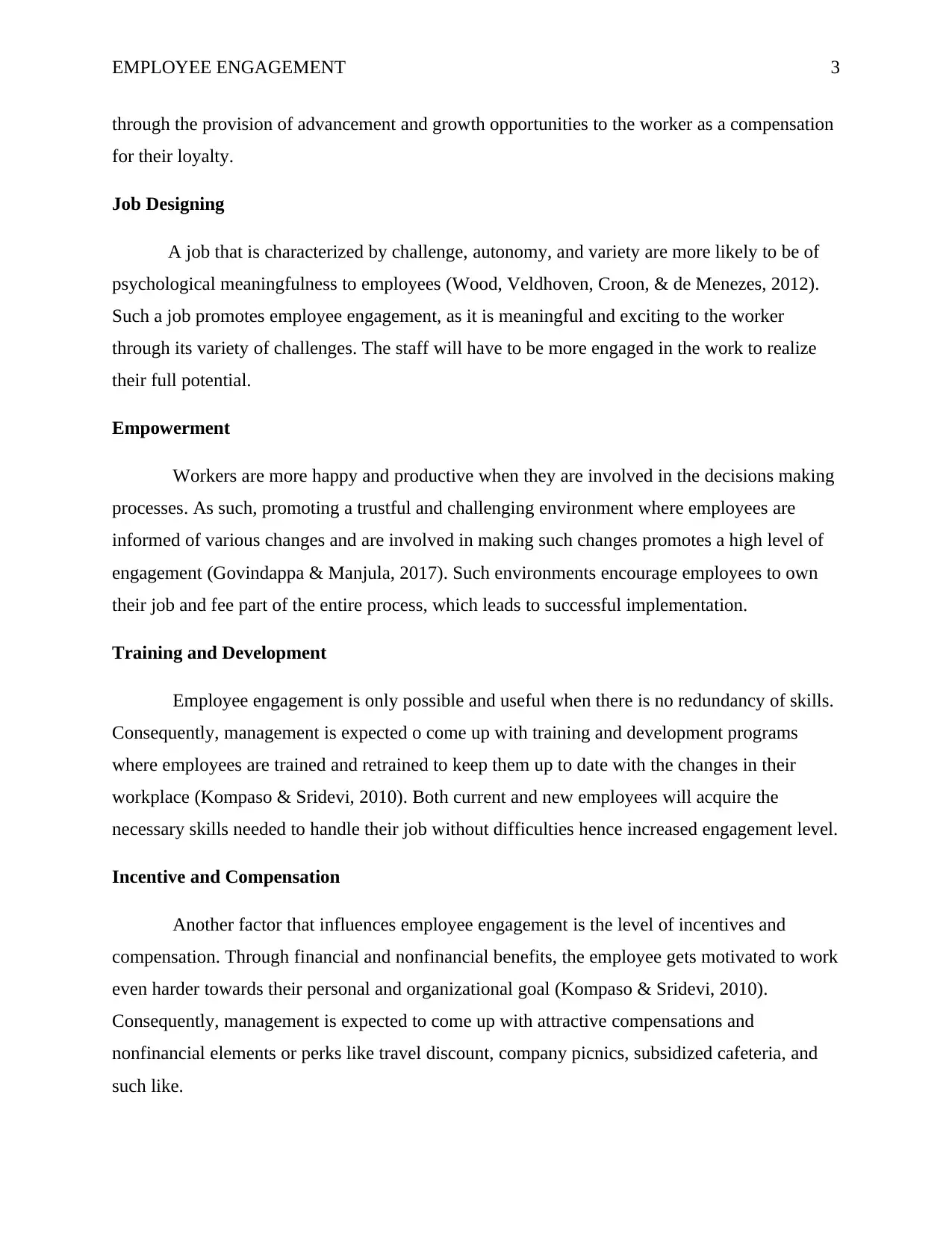
EMPLOYEE ENGAGEMENT 3
through the provision of advancement and growth opportunities to the worker as a compensation
for their loyalty.
Job Designing
A job that is characterized by challenge, autonomy, and variety are more likely to be of
psychological meaningfulness to employees (Wood, Veldhoven, Croon, & de Menezes, 2012).
Such a job promotes employee engagement, as it is meaningful and exciting to the worker
through its variety of challenges. The staff will have to be more engaged in the work to realize
their full potential.
Empowerment
Workers are more happy and productive when they are involved in the decisions making
processes. As such, promoting a trustful and challenging environment where employees are
informed of various changes and are involved in making such changes promotes a high level of
engagement (Govindappa & Manjula, 2017). Such environments encourage employees to own
their job and fee part of the entire process, which leads to successful implementation.
Training and Development
Employee engagement is only possible and useful when there is no redundancy of skills.
Consequently, management is expected o come up with training and development programs
where employees are trained and retrained to keep them up to date with the changes in their
workplace (Kompaso & Sridevi, 2010). Both current and new employees will acquire the
necessary skills needed to handle their job without difficulties hence increased engagement level.
Incentive and Compensation
Another factor that influences employee engagement is the level of incentives and
compensation. Through financial and nonfinancial benefits, the employee gets motivated to work
even harder towards their personal and organizational goal (Kompaso & Sridevi, 2010).
Consequently, management is expected to come up with attractive compensations and
nonfinancial elements or perks like travel discount, company picnics, subsidized cafeteria, and
such like.
through the provision of advancement and growth opportunities to the worker as a compensation
for their loyalty.
Job Designing
A job that is characterized by challenge, autonomy, and variety are more likely to be of
psychological meaningfulness to employees (Wood, Veldhoven, Croon, & de Menezes, 2012).
Such a job promotes employee engagement, as it is meaningful and exciting to the worker
through its variety of challenges. The staff will have to be more engaged in the work to realize
their full potential.
Empowerment
Workers are more happy and productive when they are involved in the decisions making
processes. As such, promoting a trustful and challenging environment where employees are
informed of various changes and are involved in making such changes promotes a high level of
engagement (Govindappa & Manjula, 2017). Such environments encourage employees to own
their job and fee part of the entire process, which leads to successful implementation.
Training and Development
Employee engagement is only possible and useful when there is no redundancy of skills.
Consequently, management is expected o come up with training and development programs
where employees are trained and retrained to keep them up to date with the changes in their
workplace (Kompaso & Sridevi, 2010). Both current and new employees will acquire the
necessary skills needed to handle their job without difficulties hence increased engagement level.
Incentive and Compensation
Another factor that influences employee engagement is the level of incentives and
compensation. Through financial and nonfinancial benefits, the employee gets motivated to work
even harder towards their personal and organizational goal (Kompaso & Sridevi, 2010).
Consequently, management is expected to come up with attractive compensations and
nonfinancial elements or perks like travel discount, company picnics, subsidized cafeteria, and
such like.
⊘ This is a preview!⊘
Do you want full access?
Subscribe today to unlock all pages.

Trusted by 1+ million students worldwide
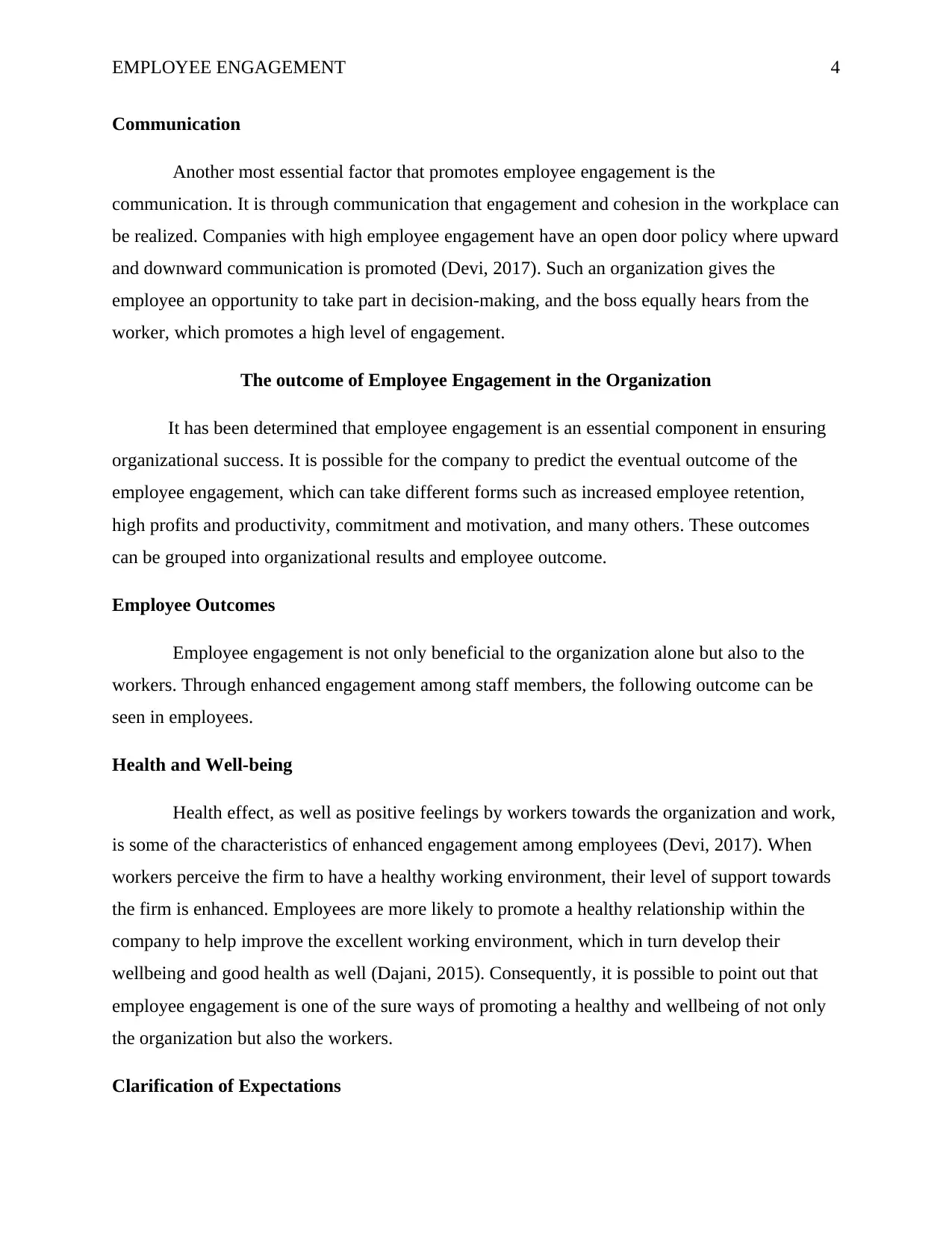
EMPLOYEE ENGAGEMENT 4
Communication
Another most essential factor that promotes employee engagement is the
communication. It is through communication that engagement and cohesion in the workplace can
be realized. Companies with high employee engagement have an open door policy where upward
and downward communication is promoted (Devi, 2017). Such an organization gives the
employee an opportunity to take part in decision-making, and the boss equally hears from the
worker, which promotes a high level of engagement.
The outcome of Employee Engagement in the Organization
It has been determined that employee engagement is an essential component in ensuring
organizational success. It is possible for the company to predict the eventual outcome of the
employee engagement, which can take different forms such as increased employee retention,
high profits and productivity, commitment and motivation, and many others. These outcomes
can be grouped into organizational results and employee outcome.
Employee Outcomes
Employee engagement is not only beneficial to the organization alone but also to the
workers. Through enhanced engagement among staff members, the following outcome can be
seen in employees.
Health and Well-being
Health effect, as well as positive feelings by workers towards the organization and work,
is some of the characteristics of enhanced engagement among employees (Devi, 2017). When
workers perceive the firm to have a healthy working environment, their level of support towards
the firm is enhanced. Employees are more likely to promote a healthy relationship within the
company to help improve the excellent working environment, which in turn develop their
wellbeing and good health as well (Dajani, 2015). Consequently, it is possible to point out that
employee engagement is one of the sure ways of promoting a healthy and wellbeing of not only
the organization but also the workers.
Clarification of Expectations
Communication
Another most essential factor that promotes employee engagement is the
communication. It is through communication that engagement and cohesion in the workplace can
be realized. Companies with high employee engagement have an open door policy where upward
and downward communication is promoted (Devi, 2017). Such an organization gives the
employee an opportunity to take part in decision-making, and the boss equally hears from the
worker, which promotes a high level of engagement.
The outcome of Employee Engagement in the Organization
It has been determined that employee engagement is an essential component in ensuring
organizational success. It is possible for the company to predict the eventual outcome of the
employee engagement, which can take different forms such as increased employee retention,
high profits and productivity, commitment and motivation, and many others. These outcomes
can be grouped into organizational results and employee outcome.
Employee Outcomes
Employee engagement is not only beneficial to the organization alone but also to the
workers. Through enhanced engagement among staff members, the following outcome can be
seen in employees.
Health and Well-being
Health effect, as well as positive feelings by workers towards the organization and work,
is some of the characteristics of enhanced engagement among employees (Devi, 2017). When
workers perceive the firm to have a healthy working environment, their level of support towards
the firm is enhanced. Employees are more likely to promote a healthy relationship within the
company to help improve the excellent working environment, which in turn develop their
wellbeing and good health as well (Dajani, 2015). Consequently, it is possible to point out that
employee engagement is one of the sure ways of promoting a healthy and wellbeing of not only
the organization but also the workers.
Clarification of Expectations
Paraphrase This Document
Need a fresh take? Get an instant paraphrase of this document with our AI Paraphraser
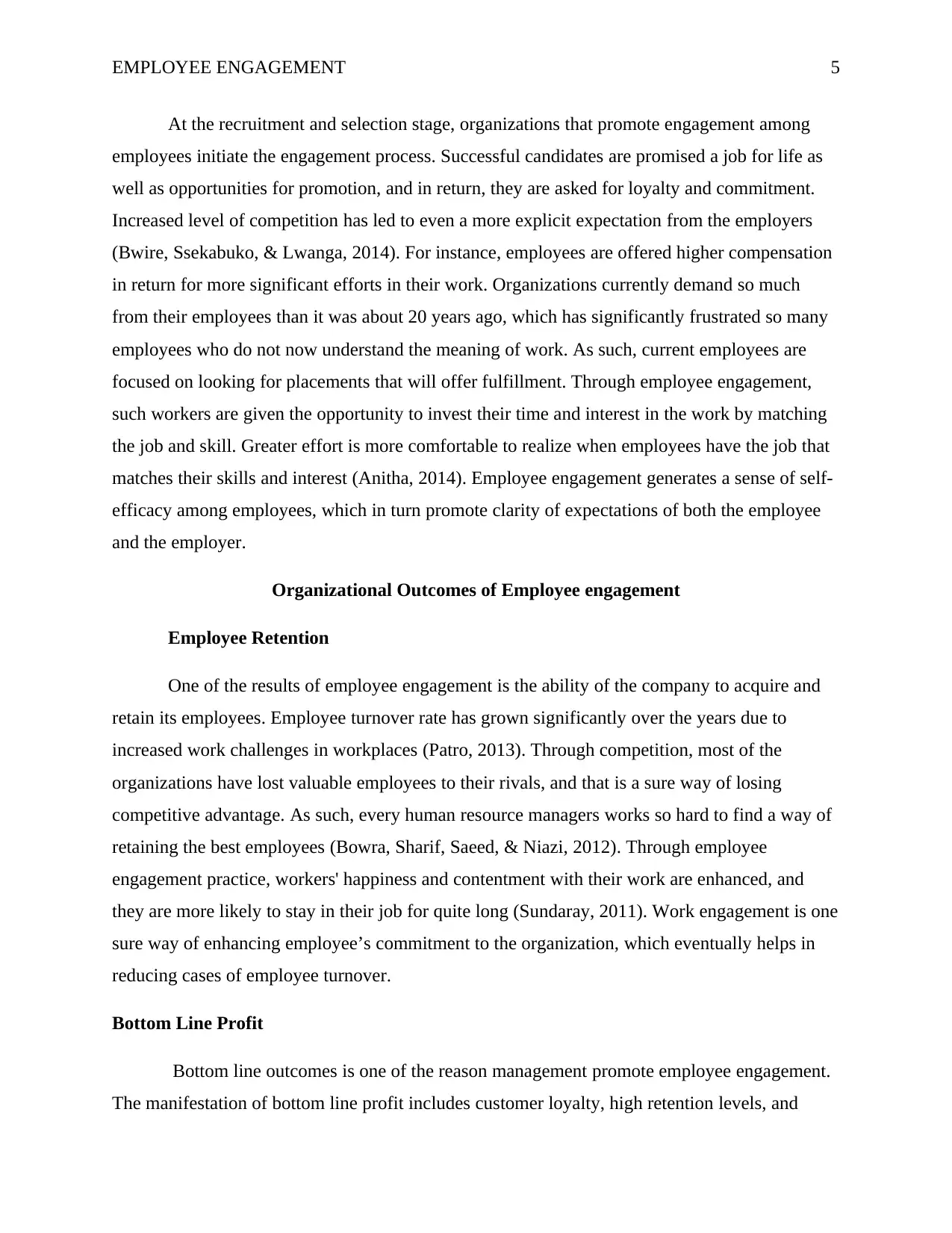
EMPLOYEE ENGAGEMENT 5
At the recruitment and selection stage, organizations that promote engagement among
employees initiate the engagement process. Successful candidates are promised a job for life as
well as opportunities for promotion, and in return, they are asked for loyalty and commitment.
Increased level of competition has led to even a more explicit expectation from the employers
(Bwire, Ssekabuko, & Lwanga, 2014). For instance, employees are offered higher compensation
in return for more significant efforts in their work. Organizations currently demand so much
from their employees than it was about 20 years ago, which has significantly frustrated so many
employees who do not now understand the meaning of work. As such, current employees are
focused on looking for placements that will offer fulfillment. Through employee engagement,
such workers are given the opportunity to invest their time and interest in the work by matching
the job and skill. Greater effort is more comfortable to realize when employees have the job that
matches their skills and interest (Anitha, 2014). Employee engagement generates a sense of self-
efficacy among employees, which in turn promote clarity of expectations of both the employee
and the employer.
Organizational Outcomes of Employee engagement
Employee Retention
One of the results of employee engagement is the ability of the company to acquire and
retain its employees. Employee turnover rate has grown significantly over the years due to
increased work challenges in workplaces (Patro, 2013). Through competition, most of the
organizations have lost valuable employees to their rivals, and that is a sure way of losing
competitive advantage. As such, every human resource managers works so hard to find a way of
retaining the best employees (Bowra, Sharif, Saeed, & Niazi, 2012). Through employee
engagement practice, workers' happiness and contentment with their work are enhanced, and
they are more likely to stay in their job for quite long (Sundaray, 2011). Work engagement is one
sure way of enhancing employee’s commitment to the organization, which eventually helps in
reducing cases of employee turnover.
Bottom Line Profit
Bottom line outcomes is one of the reason management promote employee engagement.
The manifestation of bottom line profit includes customer loyalty, high retention levels, and
At the recruitment and selection stage, organizations that promote engagement among
employees initiate the engagement process. Successful candidates are promised a job for life as
well as opportunities for promotion, and in return, they are asked for loyalty and commitment.
Increased level of competition has led to even a more explicit expectation from the employers
(Bwire, Ssekabuko, & Lwanga, 2014). For instance, employees are offered higher compensation
in return for more significant efforts in their work. Organizations currently demand so much
from their employees than it was about 20 years ago, which has significantly frustrated so many
employees who do not now understand the meaning of work. As such, current employees are
focused on looking for placements that will offer fulfillment. Through employee engagement,
such workers are given the opportunity to invest their time and interest in the work by matching
the job and skill. Greater effort is more comfortable to realize when employees have the job that
matches their skills and interest (Anitha, 2014). Employee engagement generates a sense of self-
efficacy among employees, which in turn promote clarity of expectations of both the employee
and the employer.
Organizational Outcomes of Employee engagement
Employee Retention
One of the results of employee engagement is the ability of the company to acquire and
retain its employees. Employee turnover rate has grown significantly over the years due to
increased work challenges in workplaces (Patro, 2013). Through competition, most of the
organizations have lost valuable employees to their rivals, and that is a sure way of losing
competitive advantage. As such, every human resource managers works so hard to find a way of
retaining the best employees (Bowra, Sharif, Saeed, & Niazi, 2012). Through employee
engagement practice, workers' happiness and contentment with their work are enhanced, and
they are more likely to stay in their job for quite long (Sundaray, 2011). Work engagement is one
sure way of enhancing employee’s commitment to the organization, which eventually helps in
reducing cases of employee turnover.
Bottom Line Profit
Bottom line outcomes is one of the reason management promote employee engagement.
The manifestation of bottom line profit includes customer loyalty, high retention levels, and
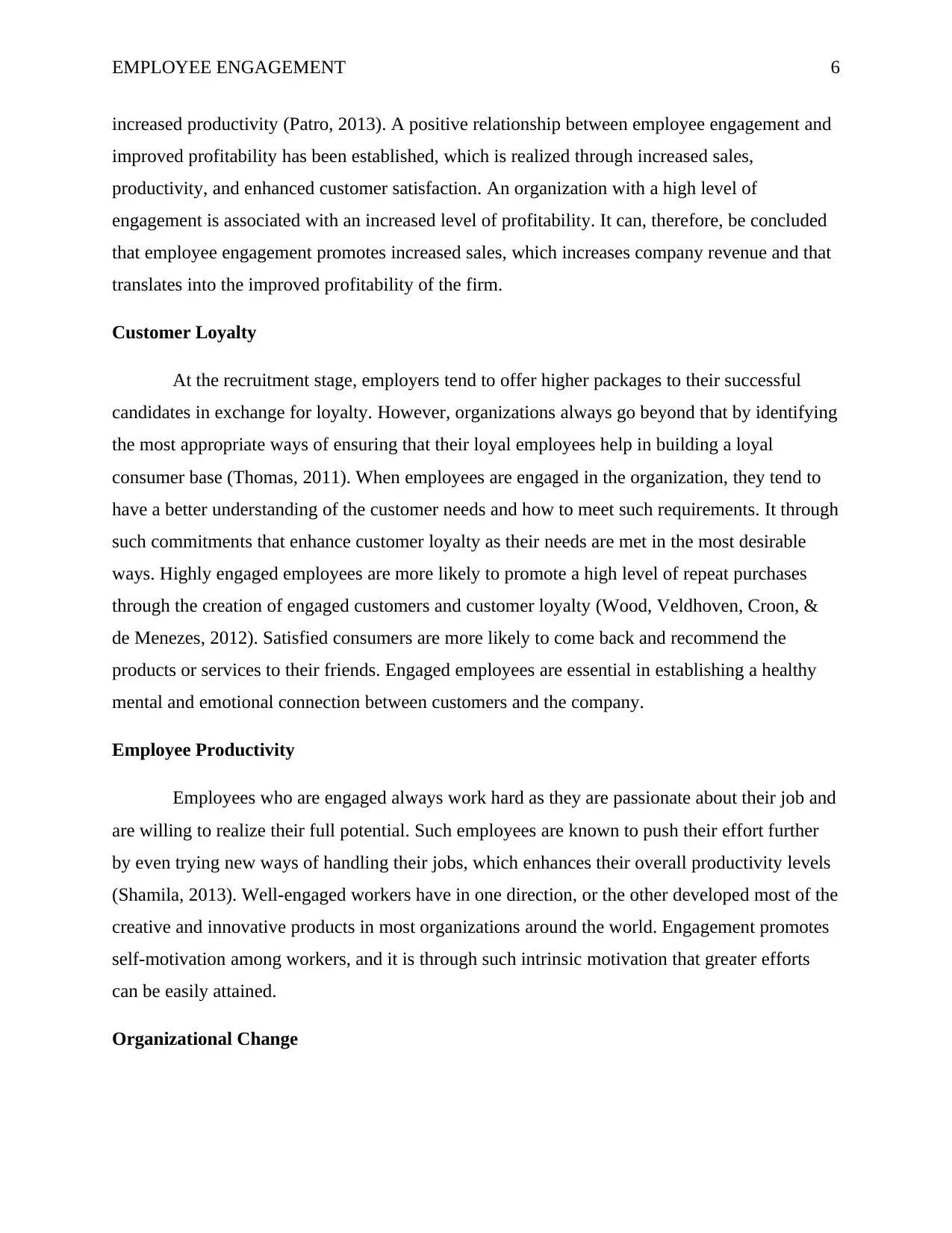
EMPLOYEE ENGAGEMENT 6
increased productivity (Patro, 2013). A positive relationship between employee engagement and
improved profitability has been established, which is realized through increased sales,
productivity, and enhanced customer satisfaction. An organization with a high level of
engagement is associated with an increased level of profitability. It can, therefore, be concluded
that employee engagement promotes increased sales, which increases company revenue and that
translates into the improved profitability of the firm.
Customer Loyalty
At the recruitment stage, employers tend to offer higher packages to their successful
candidates in exchange for loyalty. However, organizations always go beyond that by identifying
the most appropriate ways of ensuring that their loyal employees help in building a loyal
consumer base (Thomas, 2011). When employees are engaged in the organization, they tend to
have a better understanding of the customer needs and how to meet such requirements. It through
such commitments that enhance customer loyalty as their needs are met in the most desirable
ways. Highly engaged employees are more likely to promote a high level of repeat purchases
through the creation of engaged customers and customer loyalty (Wood, Veldhoven, Croon, &
de Menezes, 2012). Satisfied consumers are more likely to come back and recommend the
products or services to their friends. Engaged employees are essential in establishing a healthy
mental and emotional connection between customers and the company.
Employee Productivity
Employees who are engaged always work hard as they are passionate about their job and
are willing to realize their full potential. Such employees are known to push their effort further
by even trying new ways of handling their jobs, which enhances their overall productivity levels
(Shamila, 2013). Well-engaged workers have in one direction, or the other developed most of the
creative and innovative products in most organizations around the world. Engagement promotes
self-motivation among workers, and it is through such intrinsic motivation that greater efforts
can be easily attained.
Organizational Change
increased productivity (Patro, 2013). A positive relationship between employee engagement and
improved profitability has been established, which is realized through increased sales,
productivity, and enhanced customer satisfaction. An organization with a high level of
engagement is associated with an increased level of profitability. It can, therefore, be concluded
that employee engagement promotes increased sales, which increases company revenue and that
translates into the improved profitability of the firm.
Customer Loyalty
At the recruitment stage, employers tend to offer higher packages to their successful
candidates in exchange for loyalty. However, organizations always go beyond that by identifying
the most appropriate ways of ensuring that their loyal employees help in building a loyal
consumer base (Thomas, 2011). When employees are engaged in the organization, they tend to
have a better understanding of the customer needs and how to meet such requirements. It through
such commitments that enhance customer loyalty as their needs are met in the most desirable
ways. Highly engaged employees are more likely to promote a high level of repeat purchases
through the creation of engaged customers and customer loyalty (Wood, Veldhoven, Croon, &
de Menezes, 2012). Satisfied consumers are more likely to come back and recommend the
products or services to their friends. Engaged employees are essential in establishing a healthy
mental and emotional connection between customers and the company.
Employee Productivity
Employees who are engaged always work hard as they are passionate about their job and
are willing to realize their full potential. Such employees are known to push their effort further
by even trying new ways of handling their jobs, which enhances their overall productivity levels
(Shamila, 2013). Well-engaged workers have in one direction, or the other developed most of the
creative and innovative products in most organizations around the world. Engagement promotes
self-motivation among workers, and it is through such intrinsic motivation that greater efforts
can be easily attained.
Organizational Change
⊘ This is a preview!⊘
Do you want full access?
Subscribe today to unlock all pages.

Trusted by 1+ million students worldwide
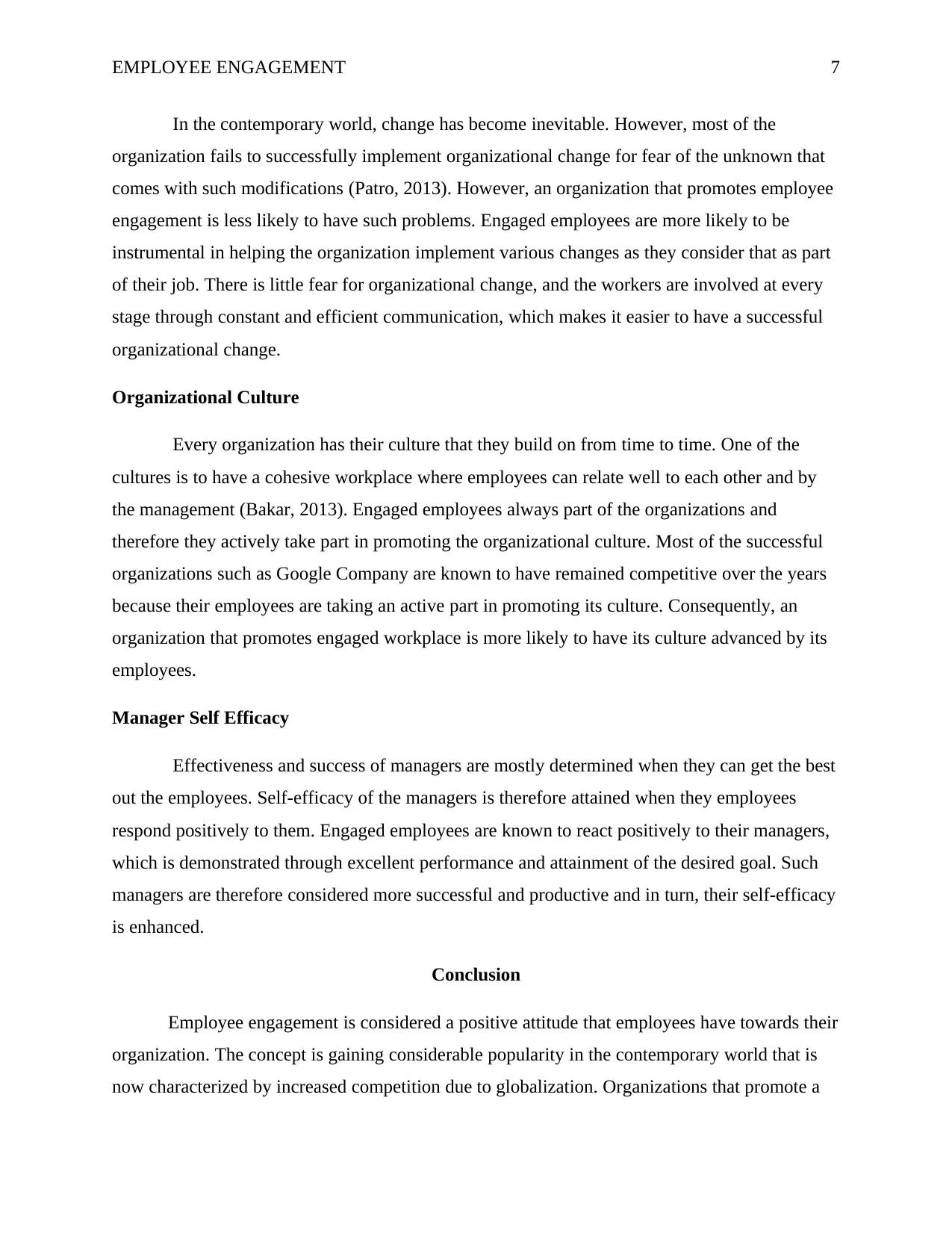
EMPLOYEE ENGAGEMENT 7
In the contemporary world, change has become inevitable. However, most of the
organization fails to successfully implement organizational change for fear of the unknown that
comes with such modifications (Patro, 2013). However, an organization that promotes employee
engagement is less likely to have such problems. Engaged employees are more likely to be
instrumental in helping the organization implement various changes as they consider that as part
of their job. There is little fear for organizational change, and the workers are involved at every
stage through constant and efficient communication, which makes it easier to have a successful
organizational change.
Organizational Culture
Every organization has their culture that they build on from time to time. One of the
cultures is to have a cohesive workplace where employees can relate well to each other and by
the management (Bakar, 2013). Engaged employees always part of the organizations and
therefore they actively take part in promoting the organizational culture. Most of the successful
organizations such as Google Company are known to have remained competitive over the years
because their employees are taking an active part in promoting its culture. Consequently, an
organization that promotes engaged workplace is more likely to have its culture advanced by its
employees.
Manager Self Efficacy
Effectiveness and success of managers are mostly determined when they can get the best
out the employees. Self-efficacy of the managers is therefore attained when they employees
respond positively to them. Engaged employees are known to react positively to their managers,
which is demonstrated through excellent performance and attainment of the desired goal. Such
managers are therefore considered more successful and productive and in turn, their self-efficacy
is enhanced.
Conclusion
Employee engagement is considered a positive attitude that employees have towards their
organization. The concept is gaining considerable popularity in the contemporary world that is
now characterized by increased competition due to globalization. Organizations that promote a
In the contemporary world, change has become inevitable. However, most of the
organization fails to successfully implement organizational change for fear of the unknown that
comes with such modifications (Patro, 2013). However, an organization that promotes employee
engagement is less likely to have such problems. Engaged employees are more likely to be
instrumental in helping the organization implement various changes as they consider that as part
of their job. There is little fear for organizational change, and the workers are involved at every
stage through constant and efficient communication, which makes it easier to have a successful
organizational change.
Organizational Culture
Every organization has their culture that they build on from time to time. One of the
cultures is to have a cohesive workplace where employees can relate well to each other and by
the management (Bakar, 2013). Engaged employees always part of the organizations and
therefore they actively take part in promoting the organizational culture. Most of the successful
organizations such as Google Company are known to have remained competitive over the years
because their employees are taking an active part in promoting its culture. Consequently, an
organization that promotes engaged workplace is more likely to have its culture advanced by its
employees.
Manager Self Efficacy
Effectiveness and success of managers are mostly determined when they can get the best
out the employees. Self-efficacy of the managers is therefore attained when they employees
respond positively to them. Engaged employees are known to react positively to their managers,
which is demonstrated through excellent performance and attainment of the desired goal. Such
managers are therefore considered more successful and productive and in turn, their self-efficacy
is enhanced.
Conclusion
Employee engagement is considered a positive attitude that employees have towards their
organization. The concept is gaining considerable popularity in the contemporary world that is
now characterized by increased competition due to globalization. Organizations that promote a
Paraphrase This Document
Need a fresh take? Get an instant paraphrase of this document with our AI Paraphraser
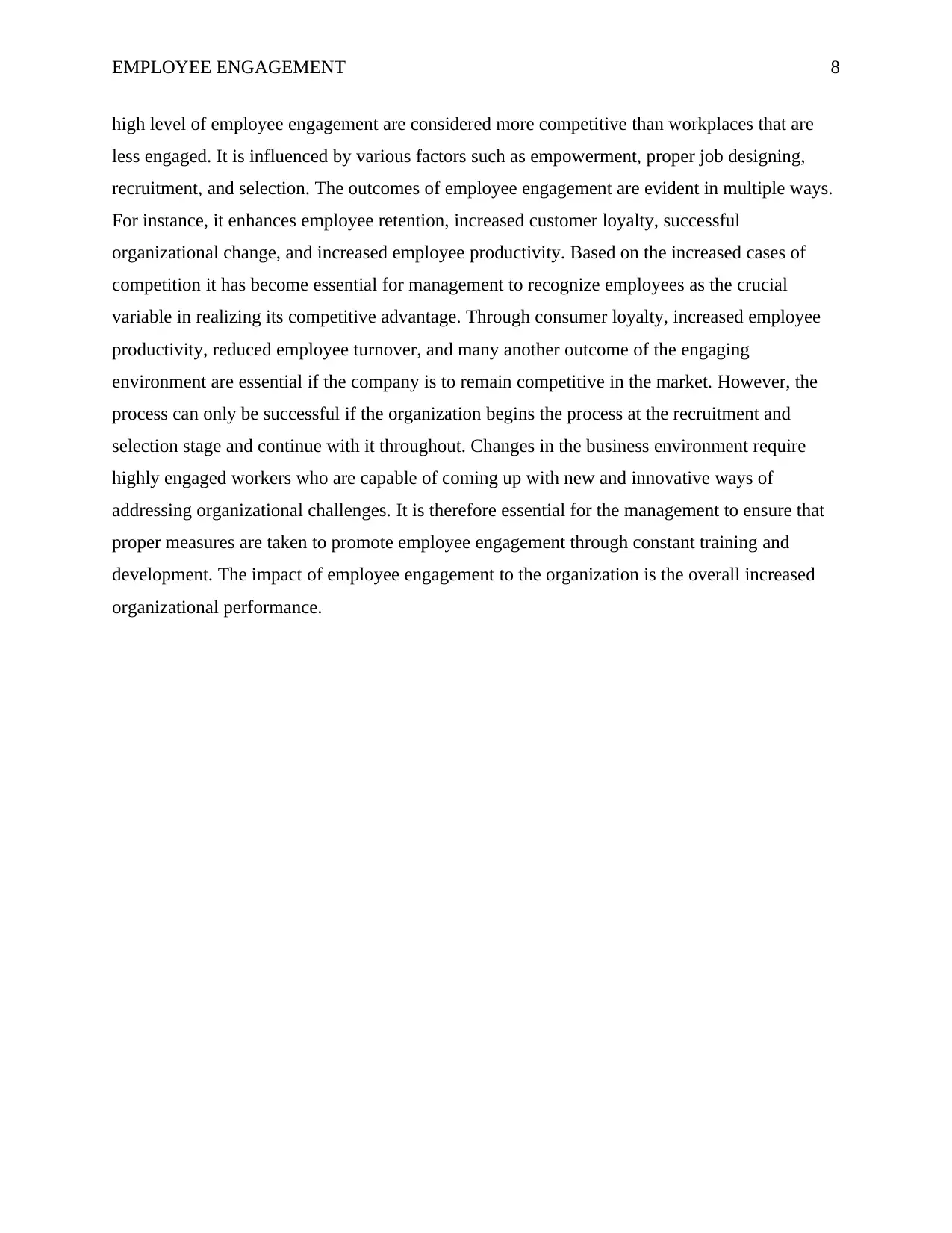
EMPLOYEE ENGAGEMENT 8
high level of employee engagement are considered more competitive than workplaces that are
less engaged. It is influenced by various factors such as empowerment, proper job designing,
recruitment, and selection. The outcomes of employee engagement are evident in multiple ways.
For instance, it enhances employee retention, increased customer loyalty, successful
organizational change, and increased employee productivity. Based on the increased cases of
competition it has become essential for management to recognize employees as the crucial
variable in realizing its competitive advantage. Through consumer loyalty, increased employee
productivity, reduced employee turnover, and many another outcome of the engaging
environment are essential if the company is to remain competitive in the market. However, the
process can only be successful if the organization begins the process at the recruitment and
selection stage and continue with it throughout. Changes in the business environment require
highly engaged workers who are capable of coming up with new and innovative ways of
addressing organizational challenges. It is therefore essential for the management to ensure that
proper measures are taken to promote employee engagement through constant training and
development. The impact of employee engagement to the organization is the overall increased
organizational performance.
high level of employee engagement are considered more competitive than workplaces that are
less engaged. It is influenced by various factors such as empowerment, proper job designing,
recruitment, and selection. The outcomes of employee engagement are evident in multiple ways.
For instance, it enhances employee retention, increased customer loyalty, successful
organizational change, and increased employee productivity. Based on the increased cases of
competition it has become essential for management to recognize employees as the crucial
variable in realizing its competitive advantage. Through consumer loyalty, increased employee
productivity, reduced employee turnover, and many another outcome of the engaging
environment are essential if the company is to remain competitive in the market. However, the
process can only be successful if the organization begins the process at the recruitment and
selection stage and continue with it throughout. Changes in the business environment require
highly engaged workers who are capable of coming up with new and innovative ways of
addressing organizational challenges. It is therefore essential for the management to ensure that
proper measures are taken to promote employee engagement through constant training and
development. The impact of employee engagement to the organization is the overall increased
organizational performance.
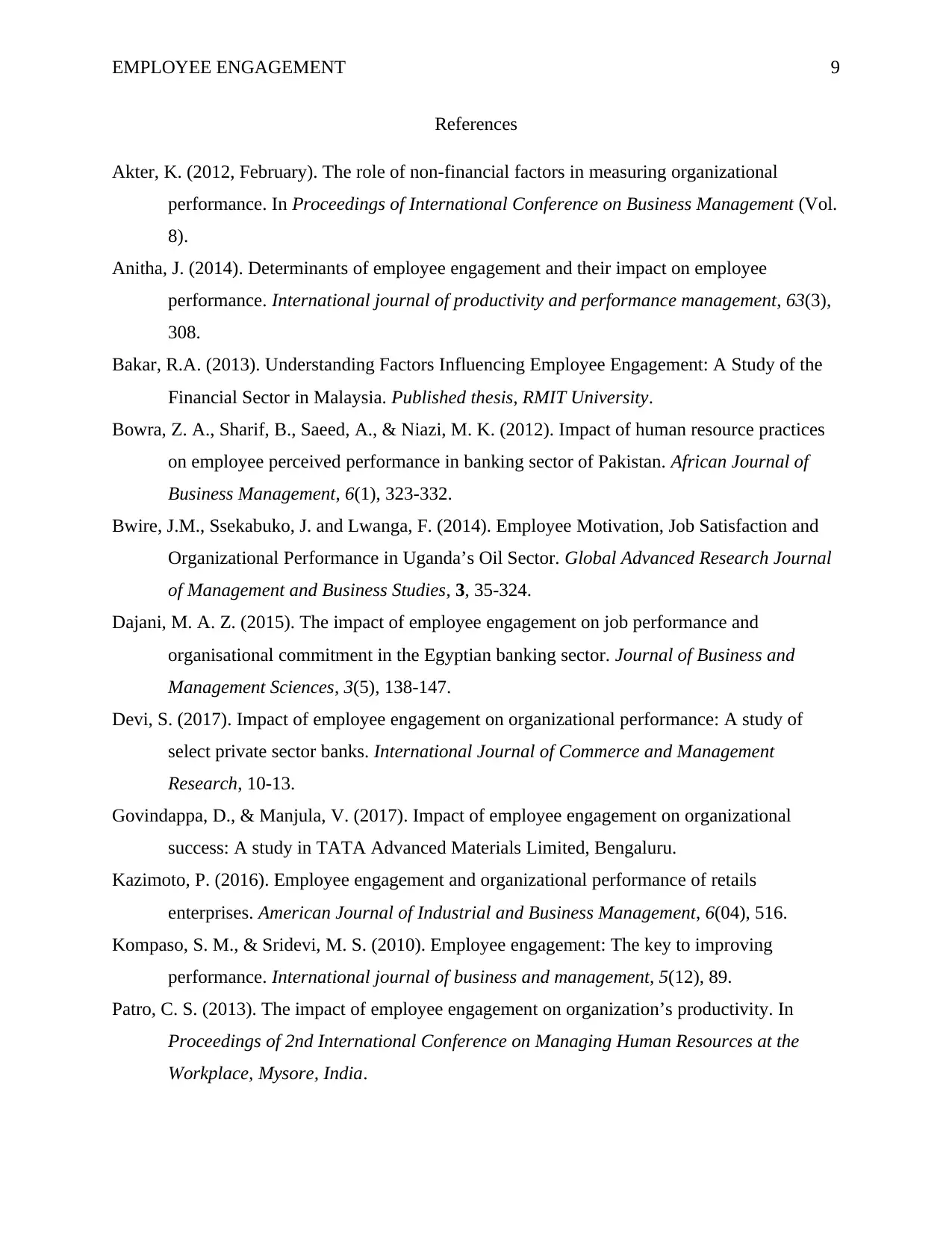
EMPLOYEE ENGAGEMENT 9
References
Akter, K. (2012, February). The role of non-financial factors in measuring organizational
performance. In Proceedings of International Conference on Business Management (Vol.
8).
Anitha, J. (2014). Determinants of employee engagement and their impact on employee
performance. International journal of productivity and performance management, 63(3),
308.
Bakar, R.A. (2013). Understanding Factors Influencing Employee Engagement: A Study of the
Financial Sector in Malaysia. Published thesis, RMIT University.
Bowra, Z. A., Sharif, B., Saeed, A., & Niazi, M. K. (2012). Impact of human resource practices
on employee perceived performance in banking sector of Pakistan. African Journal of
Business Management, 6(1), 323-332.
Bwire, J.M., Ssekabuko, J. and Lwanga, F. (2014). Employee Motivation, Job Satisfaction and
Organizational Performance in Uganda’s Oil Sector. Global Advanced Research Journal
of Management and Business Studies, 3, 35-324.
Dajani, M. A. Z. (2015). The impact of employee engagement on job performance and
organisational commitment in the Egyptian banking sector. Journal of Business and
Management Sciences, 3(5), 138-147.
Devi, S. (2017). Impact of employee engagement on organizational performance: A study of
select private sector banks. International Journal of Commerce and Management
Research, 10-13.
Govindappa, D., & Manjula, V. (2017). Impact of employee engagement on organizational
success: A study in TATA Advanced Materials Limited, Bengaluru.
Kazimoto, P. (2016). Employee engagement and organizational performance of retails
enterprises. American Journal of Industrial and Business Management, 6(04), 516.
Kompaso, S. M., & Sridevi, M. S. (2010). Employee engagement: The key to improving
performance. International journal of business and management, 5(12), 89.
Patro, C. S. (2013). The impact of employee engagement on organization’s productivity. In
Proceedings of 2nd International Conference on Managing Human Resources at the
Workplace, Mysore, India.
References
Akter, K. (2012, February). The role of non-financial factors in measuring organizational
performance. In Proceedings of International Conference on Business Management (Vol.
8).
Anitha, J. (2014). Determinants of employee engagement and their impact on employee
performance. International journal of productivity and performance management, 63(3),
308.
Bakar, R.A. (2013). Understanding Factors Influencing Employee Engagement: A Study of the
Financial Sector in Malaysia. Published thesis, RMIT University.
Bowra, Z. A., Sharif, B., Saeed, A., & Niazi, M. K. (2012). Impact of human resource practices
on employee perceived performance in banking sector of Pakistan. African Journal of
Business Management, 6(1), 323-332.
Bwire, J.M., Ssekabuko, J. and Lwanga, F. (2014). Employee Motivation, Job Satisfaction and
Organizational Performance in Uganda’s Oil Sector. Global Advanced Research Journal
of Management and Business Studies, 3, 35-324.
Dajani, M. A. Z. (2015). The impact of employee engagement on job performance and
organisational commitment in the Egyptian banking sector. Journal of Business and
Management Sciences, 3(5), 138-147.
Devi, S. (2017). Impact of employee engagement on organizational performance: A study of
select private sector banks. International Journal of Commerce and Management
Research, 10-13.
Govindappa, D., & Manjula, V. (2017). Impact of employee engagement on organizational
success: A study in TATA Advanced Materials Limited, Bengaluru.
Kazimoto, P. (2016). Employee engagement and organizational performance of retails
enterprises. American Journal of Industrial and Business Management, 6(04), 516.
Kompaso, S. M., & Sridevi, M. S. (2010). Employee engagement: The key to improving
performance. International journal of business and management, 5(12), 89.
Patro, C. S. (2013). The impact of employee engagement on organization’s productivity. In
Proceedings of 2nd International Conference on Managing Human Resources at the
Workplace, Mysore, India.
⊘ This is a preview!⊘
Do you want full access?
Subscribe today to unlock all pages.

Trusted by 1+ million students worldwide
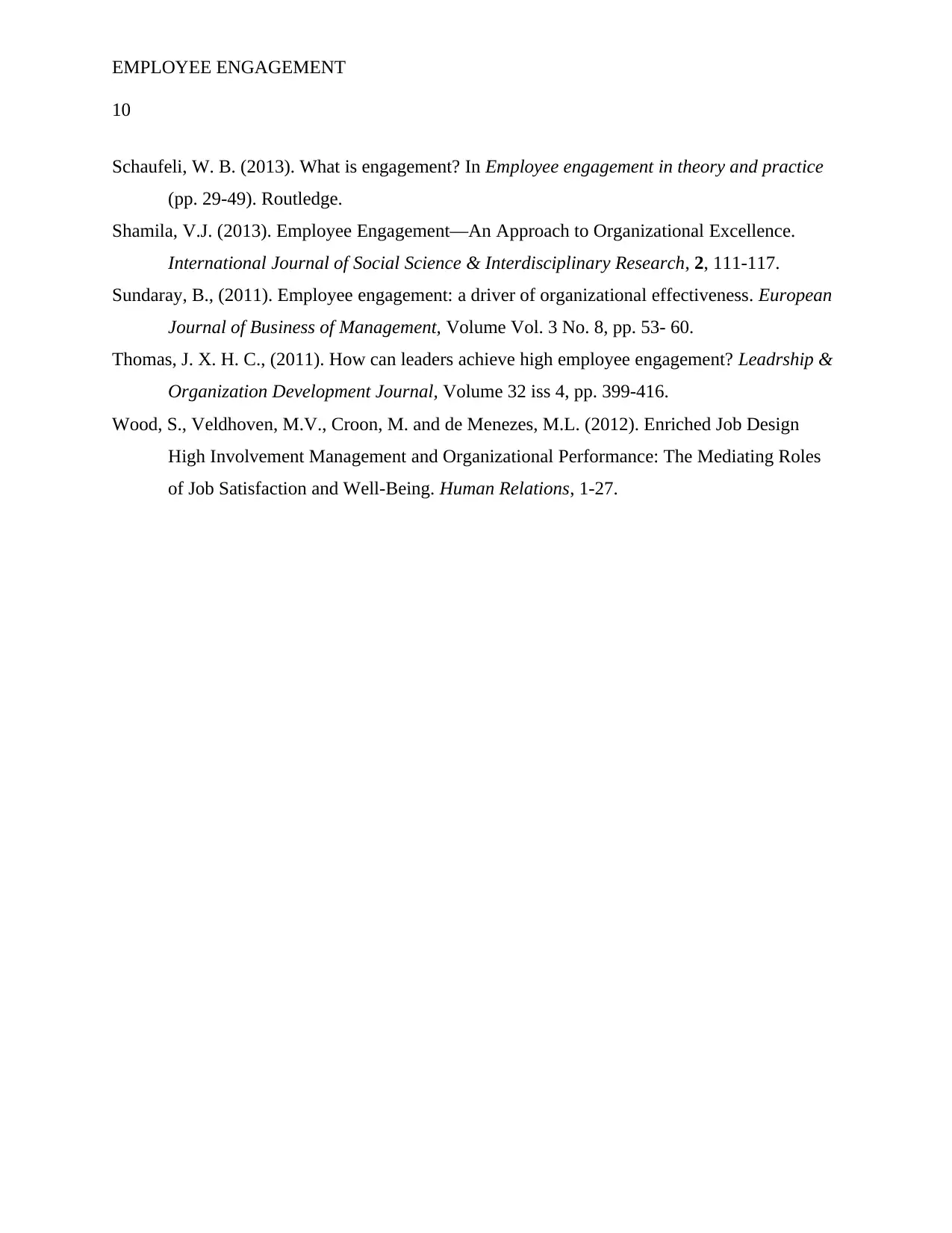
EMPLOYEE ENGAGEMENT
10
Schaufeli, W. B. (2013). What is engagement? In Employee engagement in theory and practice
(pp. 29-49). Routledge.
Shamila, V.J. (2013). Employee Engagement—An Approach to Organizational Excellence.
International Journal of Social Science & Interdisciplinary Research, 2, 111-117.
Sundaray, B., (2011). Employee engagement: a driver of organizational effectiveness. European
Journal of Business of Management, Volume Vol. 3 No. 8, pp. 53- 60.
Thomas, J. X. H. C., (2011). How can leaders achieve high employee engagement? Leadrship &
Organization Development Journal, Volume 32 iss 4, pp. 399-416.
Wood, S., Veldhoven, M.V., Croon, M. and de Menezes, M.L. (2012). Enriched Job Design
High Involvement Management and Organizational Performance: The Mediating Roles
of Job Satisfaction and Well-Being. Human Relations, 1-27.
10
Schaufeli, W. B. (2013). What is engagement? In Employee engagement in theory and practice
(pp. 29-49). Routledge.
Shamila, V.J. (2013). Employee Engagement—An Approach to Organizational Excellence.
International Journal of Social Science & Interdisciplinary Research, 2, 111-117.
Sundaray, B., (2011). Employee engagement: a driver of organizational effectiveness. European
Journal of Business of Management, Volume Vol. 3 No. 8, pp. 53- 60.
Thomas, J. X. H. C., (2011). How can leaders achieve high employee engagement? Leadrship &
Organization Development Journal, Volume 32 iss 4, pp. 399-416.
Wood, S., Veldhoven, M.V., Croon, M. and de Menezes, M.L. (2012). Enriched Job Design
High Involvement Management and Organizational Performance: The Mediating Roles
of Job Satisfaction and Well-Being. Human Relations, 1-27.
1 out of 10
Related Documents
Your All-in-One AI-Powered Toolkit for Academic Success.
+13062052269
info@desklib.com
Available 24*7 on WhatsApp / Email
![[object Object]](/_next/static/media/star-bottom.7253800d.svg)
Unlock your academic potential
Copyright © 2020–2025 A2Z Services. All Rights Reserved. Developed and managed by ZUCOL.





